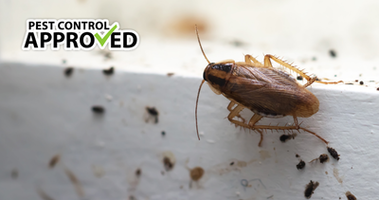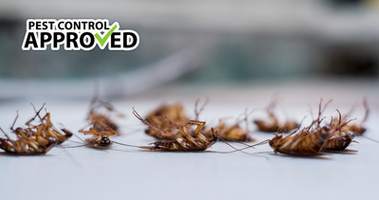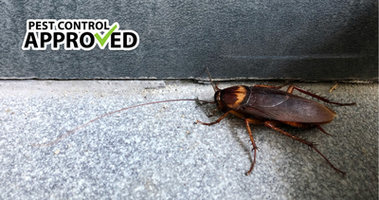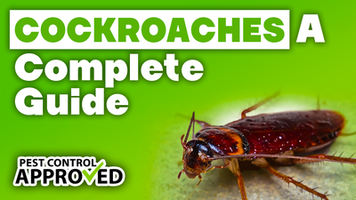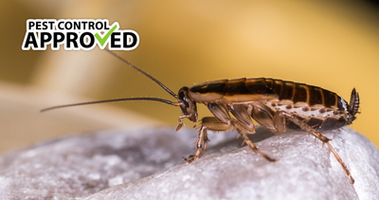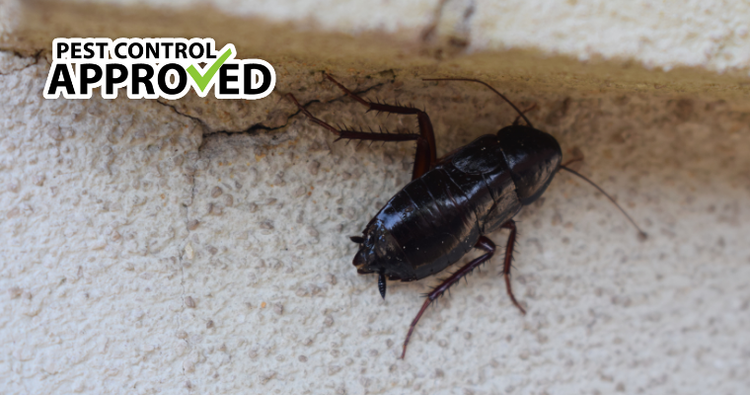
Oriental Cockroaches
Oriental cockroaches, also known as water bugs or black beetles, are a large species of cockroach. They came from the Crimean Peninsula near the Black Sea. They came to North America via trade goods and are now found worldwide. They are a slower moving cockroach that is often found outdoors.
NAME: Blatta orientalis
LOCATION: Worldwide
HABITAT: Temperate
DIET: Omnivore
SIZE: 0.71” – 1.14”
PREDATORS: Birds, reptiles
LIFE EXPECTANCY: 362 to 700 days
Size
The oriental cockroach is one of the larger species of cockroach although it is smaller than the American cockroach. Males range from 0.71 inches to 1.14 inches while females range from 0.79 inches to 1.06 inches.
Appearance
Oriental cockroaches are dark brown or black. They have a shiny, smooth appearance to their skin. Like all cockroaches, they have three segments: the head, abdomen, and thorax. Their head is shaped like a half circle and contains two straight antenna and their mouth parts. Their thorax contains their six legs. One set of legs is just below the head. The second set is in the middle of the thorax while the third is at the end of the thorax. Male and female Oriental cockroaches look different. Male Oriental cockroaches have wings that cover 75% of their abdomen, giving them a distinctive thin shape. Females have non-function wing pads and broader, heavier bodies. Neither males nor females can fly.
Diet
Oriental cockroaches have a varied diet depending on where they live. Outdoors, they primarily eat decaying organic matter and starch. Because they often reside outside, their diets often contain more non-human food than other species. This frequently includes other pests such as earwigs and ants. Indoors, they frequently eat crumbs, pet food, and garbage. Like most species, they can survive for a month without food and two weeks without water.
Habitat
Oriental cockroaches are one of the more cold tolerant species of cockroach. While they prefer temperatures around 70⁰F, they can survive freezing temperatures. They are often found in Northern states. They travel slowly and prefer dark, moist places such as leaf piles and sewers. Indoors, they frequent damp basements, porches, sinks, and other wet areas. Outdoors, they are found in bushes, under mulch, and in flower beds. Oriental cockroaches often begin life outdoors before moving indoors in search of food, water, and warmth. They enter homes through cracks in the foundation, gaps in doorways, and other small entry points. Unlike most other North American cockroaches, this species often lives outdoors year-round.
Reproduction
Because they often live in colder places, Oriental cockroaches reproduce at a slower rate. Egg laying, hatching, and molting primarily occur in the summer months. Oriental cockroaches produce between 6 and 14 egg capsules in a lifetime. This averages to 8 egg capsules. Each egg case contains around sixteen eggs. The case is reddish-brown, and purse shaped. The female cockroach carries it for between twelve hours to five days. She then deposits it in a hidden spot with easy access to food and water. It takes between 42 to 81 days for the eggs to incubate and hatch. Baby Cockroaches occurs quicker in warm weather. Once they hatch, they young are left on their own to find food, water, and shelter. They have seven molts over 12 months before they become adults. Its important to contact a trained Exterminator when you find a cockroach in either a residential or commercial property.
Predators
Because Oriental cockroaches often live outdoors, they are more often eaten by predators. In the Southern USA, reptiles are their biggest predator. Toads, frogs, lizards, and geckos are adept at catching and eating cockroaches. However, in parts of the United States, the weather is too cold for many reptiles. Rodents are more likely to eat cockroaches in colder areas. While mice can eat them, rats are known for eating cockroaches. They can even eat them off of glue traps! They are able to skillfully eat them without getting caught in the glue.
In Northern states, the most likely predator of cockroaches are birds. Starlings are large enough to eat cockroaches and need insects to be able to breed. Chickens are also great bug catches and can eat lots of cockroaches if given the opportunity.
Lifespan
Oriental cockroaches live a relatively long life. They have a slower lifecycle that takes about 600 days, meaning that females live more than 700 days on average. Males live up to 362 days.


